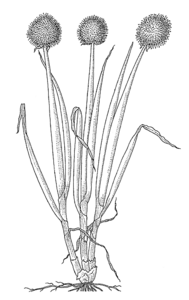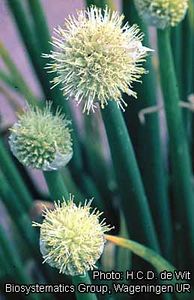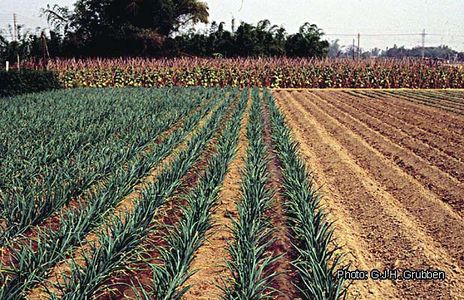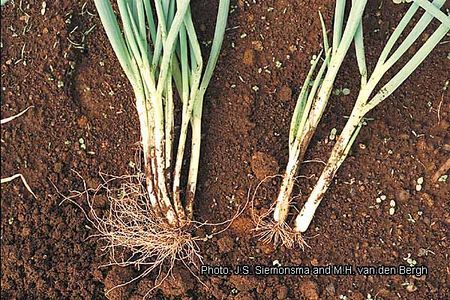Difference between revisions of "Allium fistulosum"
Maëva Rouxel (Talk | contribs) m (clean up) |
|||
| (5 intermediate revisions by 2 users not shown) | |||
| Line 5: | Line 5: | ||
|order = | |order = | ||
|family = | |family = | ||
| − | |genus = | + | |genus = Allium |
|nb chromosomes = 2n = | |nb chromosomes = 2n = | ||
|origin = area of origin | |origin = area of origin | ||
| Line 11: | Line 11: | ||
|english = | |english = | ||
|french = | |french = | ||
| + | }}{{Box | ||
| + | |title = Uses summary | ||
| + | |color = lightgreen | ||
| + | |text = | ||
}} | }} | ||
| − | + | == Description == | |
| − | + | <gallery mode="packed"> | |
| − | + | Linedrawing Allium fistulosum.gif|plant habit. Redrawn and adapted by Achmad Satiri Nurhaman | |
| + | Allium fistulosum 67.264.jpg|flowering plant | ||
| + | Allium fistulosum 27.536.jpg|inflorescence | ||
| + | Allium fistulosum 47 GG.jpg|field | ||
| + | Allium fistulosum Img0043.jpg|harvested plants | ||
| + | </gallery> | ||
== Popular names == | == Popular names == | ||
| Line 20: | Line 29: | ||
|} | |} | ||
| − | |||
| − | |||
== Classification == | == Classification == | ||
| Line 30: | Line 37: | ||
== Uses == | == Uses == | ||
| + | {{Citation box | ||
| + | |text=CIBOUL. TWO-BLADED ONION. WELSH ONION. Siberia, introduced into England in 1629<ref>Booth, W. B. ''Treas. Bot.'' 1:40. 1870.</ref>. The Welsh onion acquired its name from the German walsch (foreign)<ref>Pickering, C. ''Chron. Hist. Pls.'' 582. 1879.</ref>. It never forms a bulb like the common onion but has long, tapering roots and strong fibers<ref>Booth, W. B. ''Treas. Bot.'' 1:40. 1870.</ref>. It is grown for its leaves which are used in salads. McIntosh<ref>McIntosh, C. ''Book Gard.'' 2:41. 1855.</ref> says it has a small, flat, brownish-green bulb which ripens early and keeps well and is useful for pickling. It is very hardy and, as Targioni-Tozzetti<ref>Targioni-Tozzetti ''Journ. Hort. Soc. Lond.'' 9:147. 1855.</ref> thinks, is probably the parent species of the onion. It is mentioned by McMahon<ref>McMahon, B. ''Amer. Gard. Col.'' 582. 1806.</ref> in 1806 as one of the American garden esculents; by Randolph in Virginia before 1818; and was cataloged for sale by Thorburn in 1828, as at the present time. | ||
| + | <references/> | ||
| + | |author = [[Allium (Sturtevant, 1919)#Allium fistulosum|Sturtevant, ''Notes on edible plants'', 1919]]. | ||
| + | }} | ||
== References == | == References == | ||
| Line 37: | Line 49: | ||
*[http://ecocrop.fao.org/ecocrop/srv/en/cropFindForm FAO Ecocrop] | *[http://ecocrop.fao.org/ecocrop/srv/en/cropFindForm FAO Ecocrop] | ||
*[http://www.feedipedia.org/ Feedipedia] | *[http://www.feedipedia.org/ Feedipedia] | ||
| − | |||
*[http://www.ars-grin.gov/cgi-bin/npgs/html/tax_search.pl?Allium%20fistulosum GRIN] | *[http://www.ars-grin.gov/cgi-bin/npgs/html/tax_search.pl?Allium%20fistulosum GRIN] | ||
*[http://www.ipni.org/ipni/simplePlantNameSearch.do?find_wholeName=Allium%20fistulosum&output_format=normal&query_type=by_query&back_page=query_ipni.html IPNI] | *[http://www.ipni.org/ipni/simplePlantNameSearch.do?find_wholeName=Allium%20fistulosum&output_format=normal&query_type=by_query&back_page=query_ipni.html IPNI] | ||
| Line 46: | Line 57: | ||
*[http://www.theplantlist.org/tpl1.1/search?q=Allium+fistulosum Plant List] | *[http://www.theplantlist.org/tpl1.1/search?q=Allium+fistulosum Plant List] | ||
*[http://pfaf.org/user/Plant.aspx?LatinName=Allium%20fistulosum Plants for a future] | *[http://pfaf.org/user/Plant.aspx?LatinName=Allium%20fistulosum Plants for a future] | ||
| − | *[ | + | *[[Allium fistulosum (PROSEA)|PROSEA on Pl@ntUse]] |
*[[Allium fistulosum (PROTA)|PROTA on Pl@ntUse]] | *[[Allium fistulosum (PROTA)|PROTA on Pl@ntUse]] | ||
| − | |||
*[http://www.tela-botanica.org/page:eflore_bdtfx?referentiel=bdtfx&niveau=2&module=fiche&action=fiche&type_nom=nom_scientifique&nom=Allium%20fistulosum Tela Botanica] | *[http://www.tela-botanica.org/page:eflore_bdtfx?referentiel=bdtfx&niveau=2&module=fiche&action=fiche&type_nom=nom_scientifique&nom=Allium%20fistulosum Tela Botanica] | ||
*[http://tropical.theferns.info/viewtropical.php?id=Allium%20fistulosum Useful Tropical Plants Database] | *[http://tropical.theferns.info/viewtropical.php?id=Allium%20fistulosum Useful Tropical Plants Database] | ||
*[https://fr.wikipedia.org/wiki/Allium%20fistulosum Wikipédia] | *[https://fr.wikipedia.org/wiki/Allium%20fistulosum Wikipédia] | ||
*[http://www.wikiphyto.org/wiki/Allium%20fistulosum Wikiphyto] | *[http://www.wikiphyto.org/wiki/Allium%20fistulosum Wikiphyto] | ||
| + | |||
| + | [[Category:Allium]] | ||
Latest revision as of 19:24, 16 April 2022
Allium fistulosum
| Order | [[]] |
|---|---|
| Family | [[]] |
| Genus | Allium |
2n =
Origin : area of origin
wild or cultivated
Contents
Description
Popular names
Classification
Cultivars
History
Uses
CIBOUL. TWO-BLADED ONION. WELSH ONION. Siberia, introduced into England in 1629[1]. The Welsh onion acquired its name from the German walsch (foreign)[2]. It never forms a bulb like the common onion but has long, tapering roots and strong fibers[3]. It is grown for its leaves which are used in salads. McIntosh[4] says it has a small, flat, brownish-green bulb which ripens early and keeps well and is useful for pickling. It is very hardy and, as Targioni-Tozzetti[5] thinks, is probably the parent species of the onion. It is mentioned by McMahon[6] in 1806 as one of the American garden esculents; by Randolph in Virginia before 1818; and was cataloged for sale by Thorburn in 1828, as at the present time.





